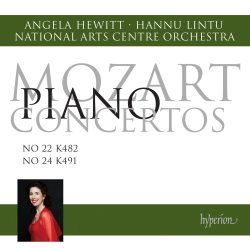|

|
Wolfgang Amadeus MOZART (1756-1791)
Piano Concerto No. 22 in E flat major, K482 (1785) [32:42]
Piano Concerto No. 24 in C minor, K491 (1786) [30:36]
Angela Hewitt (piano)
National Arts Centre Orchestra/Hannu Lintu
rec. 18-20 July 2013, National Arts Centre, Ottawa
HYPERION CDA68049 [63:20]
One of the ways in which Mozart made his living as a freelance musician in Vienna was by mounting various series of subscription concerts. It was for this reason that the piano concerto became particularly significant for him, since his own role as soloist enabled him both to maintain a high public profile and to ensure the best standard of performance. In 1784 he wrote as many as six piano concertos, and then in 1785 and 1786 he completed a further three in each year. Every one of these is a masterpiece, finer than anything he had achieved in concert music hitherto.
The Concerto K482 is the third of the three piano concertos which Mozart composed for his subscription concerts during 1785. The orchestral colouring, which includes trumpets and drums but replaces the customary oboes with clarinets, therefore tends towards warmth of tone, and in order to accommodate the variety these combinations offer, the first movement is constructed on a more than usually expansive scale. The music is typically prodigal in its melodic inventiveness, as, for example, when the piano enters upon the scene, following the beautifully crafted orchestral exposition. The soloist introduces no fewer than three new themes, two of which do not reappear in later developments. In this regard the orchestra's opening gesture becomes increasingly important, featuring a style that is somewhat restless and abounding in busy passage-work. This balance is nicely captured by Angela Hewitt and the Canadian orchestra, and the excellent recorded sound is a real bonus in this regard.
In both these performances the approach is carefully considered and there is a true understanding of the Mozartean idiom. Hewitt’s reputation, after all, goes before her. The orchestra is pared down to chamber-orchestra size, reasonably enough, but there is more romantic ardour to be found in these concertos than is revealed here. In K482 try Alfred Brendel (Decca 4425712) or, especially, Alicia de Larrocha (Eloquence 4807674) to encounter a deeper emotional response.
The C minor Concerto is the second of the three piano concertos which Mozart wrote in 1786. It employs the largest orchestra he ever used in a concerto: double woodwind (pairs of flutes, oboes, clarinets and bassoons), horns, trumpets and timpani, plus the usual grouping of strings. The scale of conception implied by these forces is matched, moreover, by the tragic intensity of the music.
It is appropriate that these performances do justice to the wonderful woodwind parts in these concertos, not least in the central slow movements. If the phrasing tends towards the prosaic rather than the emotionally indulgent that too is fine, since there is more than one way of performing a masterpiece. The string sound might have been richer, since K491 is a really powerful concerto.
These are notable performances of two of the greatest piano concertos ever written, and they eloquently communicate to the listener, though they cannot be first choices. It is pleasing to note that the identity of the cadenzas is articulated in the booklet notes.
Terry Barfoot
 |
 |
|
